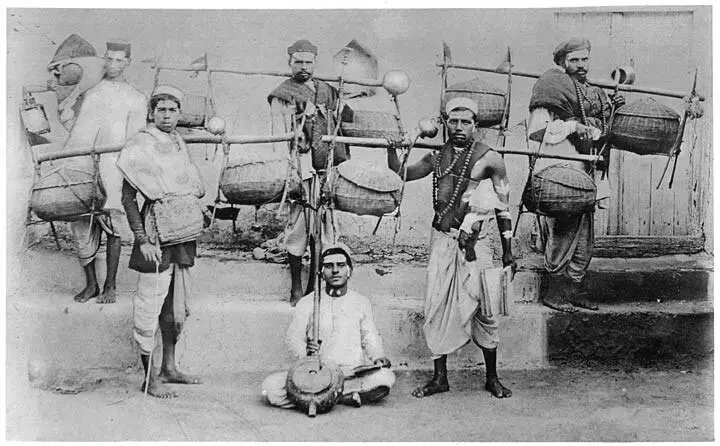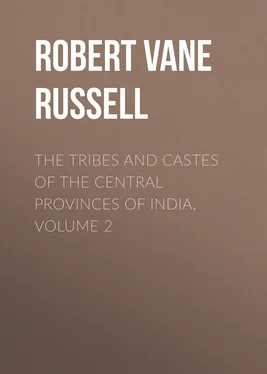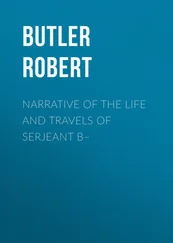Robert Vane Russell - The Tribes and Castes of the Central Provinces of India, Volume 2
Здесь есть возможность читать онлайн «Robert Vane Russell - The Tribes and Castes of the Central Provinces of India, Volume 2» — ознакомительный отрывок электронной книги совершенно бесплатно, а после прочтения отрывка купить полную версию. В некоторых случаях можно слушать аудио, скачать через торрент в формате fb2 и присутствует краткое содержание. Жанр: foreign_prose, История, foreign_edu, foreign_antique, на английском языке. Описание произведения, (предисловие) а так же отзывы посетителей доступны на портале библиотеки ЛибКат.
- Название:The Tribes and Castes of the Central Provinces of India, Volume 2
- Автор:
- Жанр:
- Год:неизвестен
- ISBN:нет данных
- Рейтинг книги:4 / 5. Голосов: 1
-
Избранное:Добавить в избранное
- Отзывы:
-
Ваша оценка:
- 80
- 1
- 2
- 3
- 4
- 5
The Tribes and Castes of the Central Provinces of India, Volume 2: краткое содержание, описание и аннотация
Предлагаем к чтению аннотацию, описание, краткое содержание или предисловие (зависит от того, что написал сам автор книги «The Tribes and Castes of the Central Provinces of India, Volume 2»). Если вы не нашли необходимую информацию о книге — напишите в комментариях, мы постараемся отыскать её.
The Tribes and Castes of the Central Provinces of India, Volume 2 — читать онлайн ознакомительный отрывок
Ниже представлен текст книги, разбитый по страницам. Система сохранения места последней прочитанной страницы, позволяет с удобством читать онлайн бесплатно книгу «The Tribes and Castes of the Central Provinces of India, Volume 2», без необходимости каждый раз заново искать на чём Вы остановились. Поставьте закладку, и сможете в любой момент перейти на страницу, на которой закончили чтение.
Интервал:
Закладка:

Pilgrims carrying water of the river Nerbudda.
The name of the Digamber or Meghdamber signifies sky-clad or cloud-clad, that is naked. They do penance in the rainy season by sitting naked in the rain for two or three hours a day with an earthen pot on the head and the hands inserted in two others so that they cannot rub the skin. In the dry season they wear only a little cloth round the waist and ashes over the rest of the body. The ashes are produced from burnt cowdung picked up off the ground, and not mixed with straw like that which is prepared for fuel.
The Khāki Bairāgis also rub ashes on the body. During the four hot months they make five fires in a circle, and kneel between them with the head and legs and arms stretched towards the fires. The fires are kindled at noon with little heaps of cowdung cakes, and the penitent stays between them till they go out. They also have a block of wood with a hole through it, into which they insert the organ of generation and suspend it by chains in front and behind. They rub ashes on the body, from which they probably get their name of Khāki or dust-colour.
The Munjia Akhāra have a belt made of munj grass round the waist, and a little apron also of grass, which is hung from it, and passed through the legs. Formerly they wore no other clothes, but now they have a cloth. They also do penance between the fires.
The Kathias have a waist-belt of bamboo fibre, to which is suspended the wooden block for the purpose already described. Their name signifies wooden, and is probably given to them on account of this custom.
The Nirmohi carry a lota or brass vessel and a little cup, in which they receive alms.
The Nirbāni wear only a piece of string or rope round the waist, to which is attached a small strip of cloth passing through the legs. When begging, they carry a kawar or banghy, holding two baskets covered with cloth, and into this they put all their alms. They never remove the cloth, but plunge their hands into the basket at random when they want something to eat. They call the basket Kāmdhenu, the name of the cow which gave inexhaustible wealth. These Bairāgis commonly marry and accumulate property.
The Lasgari are soldiers, as the name denotes. 106 106 From laskkar , an army.
They wear three straight lines of sandalwood up the forehead. It is said that on one occasion the Bairāgis were suddenly attacked by the Gosains when they had only made the white lines of the sect-mark, and they fought as they were. In consequence of this, they have ever since worn three white lines and no red one.
Others say that the Lasgari are a branch of the Digambari Akhāra, and that the Munjia and Kathia are branches of the Khāki Akhāra. They give three other Akhāras—Nīralankhi, Mahānirbāni and Santokhi—about which nothing is known.
10. The Dwāras.
Besides the Akhāras, the Bairāgis are said to have fifty-two Dwāras or doors, and every man must be a member of a Dwāra as well as of a Sampradāya and Akhāra. The Dwāras seem to have no special purpose, but in the case of Bairāgis who marry, they now serve as exogamous sections, so that members of the same Dwāra do not intermarry.
Examples of Tilaks or sect-marks worn on the forehead.
11. Initiation, appearance and customs.
A candidate for initiation has his head shaved, is invested with a necklace of beads of the tulsi or basil, and is taught a mantra or text relating to Vishnu by his preceptor. The initiation text of the Rāmānandis is said to be Om Rāmāya Nāmah , or Om , Salutation to Rāma. Om is a very sacred syllable, having much magical power. Thereafter the novice must journey to Dwārka in Gujarāt and have his body branded with hot iron or copper in the shape of Vishnu’s four implements: the chakra or discus, the guda or club, the shank or conch-shell and the padma or lotus. Sometimes these are not branded but are made daily on the arms with clay. The sect-mark should be made with Gopichandan or the milkmaid’s sandalwood. This is supposed to be clay taken from a tank at Dwārka, in which the Gopis or milkmaids who had been Krishna’s companions drowned themselves when they heard of his death. But as this can seldom be obtained any suitable whitish clay is used instead. The Bairāgis commonly let their hair grow long, after being shaved at initiation, to imitate the old forest ascetics. If a man makes a pilgrimage on foot to some famous shrine he may have his head shaved there and make an offering of his hair. Others keep their hair long and shave it only at the death of their guru or preceptor. They usually wear white clothes, and if a man has a cloth on the upper part of the body it should be folded over the shoulders and knotted at the neck. He also has a chimta or small pair of tongs, and, if he can obtain it, the skin of an Indian antelope, on which he will sit while taking his food. The skin of this animal is held to be sacred. Every Bairāgi before he takes his food should dip a sprig of tulsi or basil into it to sanctify it, and if he cannot get this he uses his necklace of tulsi -beads for the purpose instead. The caste abstain from flesh and liquor, but are addicted to the intoxicating drugs, gānja and bhāng or preparations of Indian hemp. A Hindu on meeting a Bairāgi will greet him with the phrase ‘Jai Sītārām,’ and the Bairāgi will answer, ‘Sītārām.’ This word is a conjunction of the names of Rāma and his consort Sīta. When a Bairāgi receives alms he will present to the giver a flower and a sprig of tulsi .
12. Recruitment of the order and its character.
A man belonging to any caste except the impure ones can be initiated as a Bairāgi, and the order is to a large extent recruited from the lower castes. Theoretically all members of the order should eat together; but the Brāhmans and other high castes belonging to it now eat only among themselves, except on the occasion of a Ghosti or special religious assembly, when all eat in common. As a matter of fact the order is a very mixed assortment of people. Many persons who lost their caste in the famine of 1897 from eating in Government poor-houses, joined the order and obtained a respectable position. Debtors who have become hopelessly involved sometimes find in it a means of escape from their creditors. Women of bad character, who have been expelled from their caste, are also frequently enrolled as female members, and in monasteries live openly with the men. The caste is also responsible for a good deal of crime. Not only is the disguise a very convenient one for thieves and robbers to assume on their travels, but many regular members of the order are criminally disposed. Nevertheless large numbers of Bairāgis are men who have given up their caste and families from a genuine impulse of self-sacrifice, and the desire to lead a religious life.
13. Social position and customs.
On account of their sanctity the Bairāgis have a fairly good social position, and respectable Hindu castes will accept cooked food from them. Brāhmans usually, but not always, take water. They act as gurus or spiritual guides to the laymen of all castes who can become Bairāgis. They give the Rām and Gopāl Mantras, or the texts of Rāma and Krishna, to their disciples of the three twice-born castes, and the Sheo Mantra or Siva’s text to other castes. The last is considered to be of smaller religious efficacy than the others, and is given to the lower castes and members of the higher ones who do not lead a particularly virtuous life. They invest boys with the sacred thread, and make the sect-mark on their foreheads. When they go and visit their disciples they receive presents, but do not ask them to confess their sins nor impose penalties.
Читать дальшеИнтервал:
Закладка:
Похожие книги на «The Tribes and Castes of the Central Provinces of India, Volume 2»
Представляем Вашему вниманию похожие книги на «The Tribes and Castes of the Central Provinces of India, Volume 2» списком для выбора. Мы отобрали схожую по названию и смыслу литературу в надежде предоставить читателям больше вариантов отыскать новые, интересные, ещё непрочитанные произведения.
Обсуждение, отзывы о книге «The Tribes and Castes of the Central Provinces of India, Volume 2» и просто собственные мнения читателей. Оставьте ваши комментарии, напишите, что Вы думаете о произведении, его смысле или главных героях. Укажите что конкретно понравилось, а что нет, и почему Вы так считаете.












